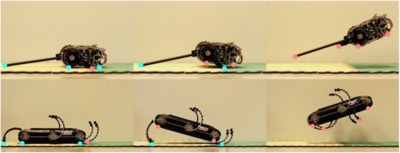
This paper explores the design space of simple legged robots capable of leaping culminating in new behaviors for the Penn Jerboa, an underactuated, dynamically dexterous robot. Using a combination of formal reasoning and physical intuition, we analyze and test successively more capable leaping behaviors through successively more complicated body mechanics. The final version of this machine studied here bounds up a ledge 1.5 times its hip height and crosses a gap 2 times its body length, exceeding in this last regard the mark set by the far more mature RHex hexapod. Theoretical contributions include a non-existence proof of a useful class of leaps for a stripped-down initial version of the new machine, setting in motion the sequence of improvements leading to the final resulting performance. Conceptual contributions include a growing understanding of the Ground Reaction Complex as an effective abstraction for classifying and generating transitional contact behaviors in robotics.

